Wideband Noise Interference Suppression for Sparsity-Based SAR Imaging Based on Dechirping and Double Subspace Extraction
Abstract
1. Introduction
2. A Brief Review of Sparsity-Based SAR Imaging
3. Impact of WBNI on Sparse Recovery
3.1. Sparse Models for Interference
3.2. Impact of WBNI on Signal Recovery
3.2.1. Case 1: μΨ = 0
3.2.2. Case 2: μΨ ≠ 0
4. WBNI Suppression Based on Dechirping and Double Subspace Extraction
4.1. Dechirping Observation
4.2. Double Subspace Extraction
4.3. Algorithm and Procedure Details
| Algorithm 1 Dechirping and double subspace extraction (DDSE) |
| Inputs: raw echo x with WBNI, random sampling matrix Ξ, Fourier basis Ω; Outputs: WBNI-free signal x*;
|
5. Experiments
5.1. Experiment Specifications
5.2. Simulation and Analysis
5.2.1. Range Profile Reconstruction
5.2.2. Range-Azimuth Imaging
6. Conclusions
Author Contributions
Funding
Conflicts of Interest
References
- Çetin, M.; Stojanovic, I.; Onhon, O.; Varshney, K.; Samadi, S.; Karl, W.C.; Willsky, A.S. Sparsity-driven synthetic aperture radar imaging: Reconstruction, autofocusing, moving targets, and compressed sensing. IEEE Signal Process. Mag. 2014, 31, 27–40. [Google Scholar] [CrossRef]
- Zhang, B.; Hong, W.; Wu, Y. Sparse microwave imaging: Principles and applications. Sci. China Inf. Sci. 2012, 55, 1722–1754. [Google Scholar] [CrossRef]
- Donoho, D.L. Compressed sensing. IEEE Trans. Inf. Theory 2006, 52, 1289–1306. [Google Scholar] [CrossRef]
- Patel, V.M.; Easley, G.R.; Healy, D.M.; Chellappa, R. Compressed synthetic aperture radar. IEEE J. Sel. Top. Signal Process. 2010, 4, 244–254. [Google Scholar] [CrossRef]
- Fang, J.; Xu, Z.; Zhang, B.; Hong, W.; Wu, Y. Fast Compressed sensing SAR imaging based on approximated observation. IEEE J. Sel. Top. Appl. Earth Obs. Remote Sens. 2014, 7, 352–363. [Google Scholar] [CrossRef]
- Soumekh, M. SAR-ECCM using phase-perturbed LFM chirp signals and DRFM repeat jammer penalization. IEEE Trans. Aerosp. Electron. Syst. 2006, 42, 191–205. [Google Scholar] [CrossRef]
- Yang, L.; Gao, S.; Hu, R.; Wei, H. Performance analysis of coherent jamming and non-coherent jamming against SAR. Syst. Eng. Electron. 2018, 40, 2444–2449. [Google Scholar]
- Li, B.; Hong, W. Study of noise jamming to SAR. Acta Electron. Sin. 2004, 32, 2035–2037. [Google Scholar]
- Orlando, D. A novel noise jamming detection algorithm for radar applications. IEEE Signal Process. Lett. 2017, 24, 206–210. [Google Scholar] [CrossRef]
- Mishali, M.; Eldar, Y.C.; Elron, A. Xampling: Signal acquisition and processing in union of subspaces. IEEE Trans. Signal Process. 2011, 59, 4719–4734. [Google Scholar] [CrossRef]
- Arias-Castro, E.; Eldar, Y.C. Noise folding in compressed sensing. IEEE Signal Process. Lett. 2012, 18, 478–481. [Google Scholar] [CrossRef]
- Davenport, M.A.; Laska, J.N.; Treichler, J.R.; Baraniuk, R.G. The pros and cons of compressive sensing for wideband signal acquisition: Noise folding versus dynamic range. IEEE Trans. Signal Process. 2012, 60, 4628–4642. [Google Scholar] [CrossRef]
- Li, D.; Zhan, M.; Fang, Z.; Xiong, H.; Jiang, Q. Parameterized wideband interference suppression for SAR imaging based on HAF. Syst. Eng. Electron. 2017, 39, 514–521. [Google Scholar]
- Su, J.; Tao, M.; Xie, J.; Wang, L. Interference Suppression for SAR Based on Ambiguity Function Iteration Decomposition. In Proceedings of the 2018 IEEE International Geoscience and Remote Sensing Symposium (IGARSS), Valencia, Spain, 22–27 July 2018. [Google Scholar] [CrossRef]
- Chen, R.; Wang, Y. Universal FRFT-based algorithm for parameter estimation of chirp signals. J. Syst. Eng. Electron. 2012, 23, 495–501. [Google Scholar] [CrossRef]
- Elgamel, S.A.; Soraghan, J.J. Using EMD-FrFT filtering to mitigate very high power interference in chirp tracking radars. IEEE Signal Process. Lett. 2011, 18, 263–266. [Google Scholar] [CrossRef]
- Su, J.; Tao, H.; Song, D.; Rao, X.; Xie, J. Interference suppression algorithm for SAR based on WD and sliding window masking technique in time-frequency domain. Acta Electron. Sin. 2015, 43, 2345–2351. [Google Scholar]
- Zhang, S.; Xing, M.; Guo, R.; Zhang, L.; Bao, Z. Interference suppression algorithm for SAR based on time–Frequency transform. IEEE Trans. Geosci. Remote Sens. 2011, 49, 3765–3779. [Google Scholar] [CrossRef]
- Tao, M.; Zhou, F.; Zhang, Z. Wideband interference mitigation in high-resolution airborne synthetic aperture radar data. IEEE Trans. Geosci. Remote Sens. 2016, 54, 74–87. [Google Scholar] [CrossRef]
- Yang, Z.; Du, W.; Liu, Z.; Liao, G. WBI suppression for SAR using iterative adaptive method. IEEE J. Sel. Top. Appl. Earth Obs. Remote Sens. 2016, 9, 1008–1014. [Google Scholar] [CrossRef]
- Lu, X.; Yang, J.; Ma, C.; Gu, H.; Su, W. Wide-band interference mitigation algorithm for SAR based on time-varying filtering and sparse recovery. Electron. Lett. 2018, 54, 165–167. [Google Scholar] [CrossRef]
- Liu, H.; Li, D.; Zhou, Y.; Truong, T. Joint wideband interference suppression and SAR signal recovery based on sparse representations. IEEE Geosci. Remote Sens. Lett. 2017, 14, 1542–1546. [Google Scholar] [CrossRef]
- Liu, H.; Li, D.; Zhou, Y.; Truong, T. Simultaneous Radio Frequency and Wideband Interference Suppression in SAR Signals via Sparsity Exploitation in Time-Frequency Domain. IEEE Trans. Geosci. Remote Sens. 2018, 56, 5780–5793. [Google Scholar] [CrossRef]
- Chen, S.S.; Donoho, D.L.; Saunders, M.A. Atomic decomposition by basis pursuit. SIAM Rev. 2001, 43, 129–159. [Google Scholar] [CrossRef]
- Kang, R.; Tian, P.; Yu, Y. An adaptive compressed sensing method based on selective measure. Acta Phys. Sin. 2014, 63, 143–150. [Google Scholar]
- Cumming, I.G.; Dettwiler, M. Digital Processing of Synthetic Aperture Radar Data: Algorithms and Implementation; Artech House: Norwood, MA, USA, 2004. [Google Scholar]
- Tropp, J.A.; Gilbert, A.C. Signal recovery from random measurements via orthogonal matching pursuit. IEEE Trans. Inf. Theory 2007, 53, 4655–4666. [Google Scholar] [CrossRef]
- Elad, M.; Bruckstein, A.M. A generalized uncertainty principle and sparse representation in pairs of bases. IEEE Trans. Inf. Theory 2002, 48, 2558–2567. [Google Scholar] [CrossRef]
- Zhang, X. Matrix Analysis and Applications, 2nd ed.; Tsinghua University Press: Beijing, China, 2004. [Google Scholar]
- Caputi, W.J. Stretch: A time-transformation technique. IEEE Trans. Aerosp. Electron. Syst. 1971, AES-7, 269–278. [Google Scholar] [CrossRef]
- Ma, J.; Liu, C.; Gan, L. CFAR target detection algorithm based on compressive sensing. J. Electron. Inf. Technol. 2017, 39, 2899–2904. [Google Scholar]
- Gandhi, P.; Kassam, S. Analysis of CFAR processors in nonhomogeneous background. IEEE Trans. Aerosp. Electron. Syst. 1988, 24, 427–445. [Google Scholar] [CrossRef]
- Lu, X.; Su, W.; Yang, J.; Gu, H.; Zhang, H.; Yu, W.; Yeo, T.S. Radio frequency interference suppression for SAR via block sparse Bayesian learning. IEEE J. Sel. Top. Appl. Earth Obs. Remote Sens. 2018, 11, 4835–4847. [Google Scholar] [CrossRef]
- Li, G.; Ye, W.; Lao, G.; Kong, S.; Yan, D. Narrowband interference separation for synthetic aperture radar via sensing matrix optimization-based block sparse Bayesian learning. Electronics 2019, 8, 458. [Google Scholar] [CrossRef]
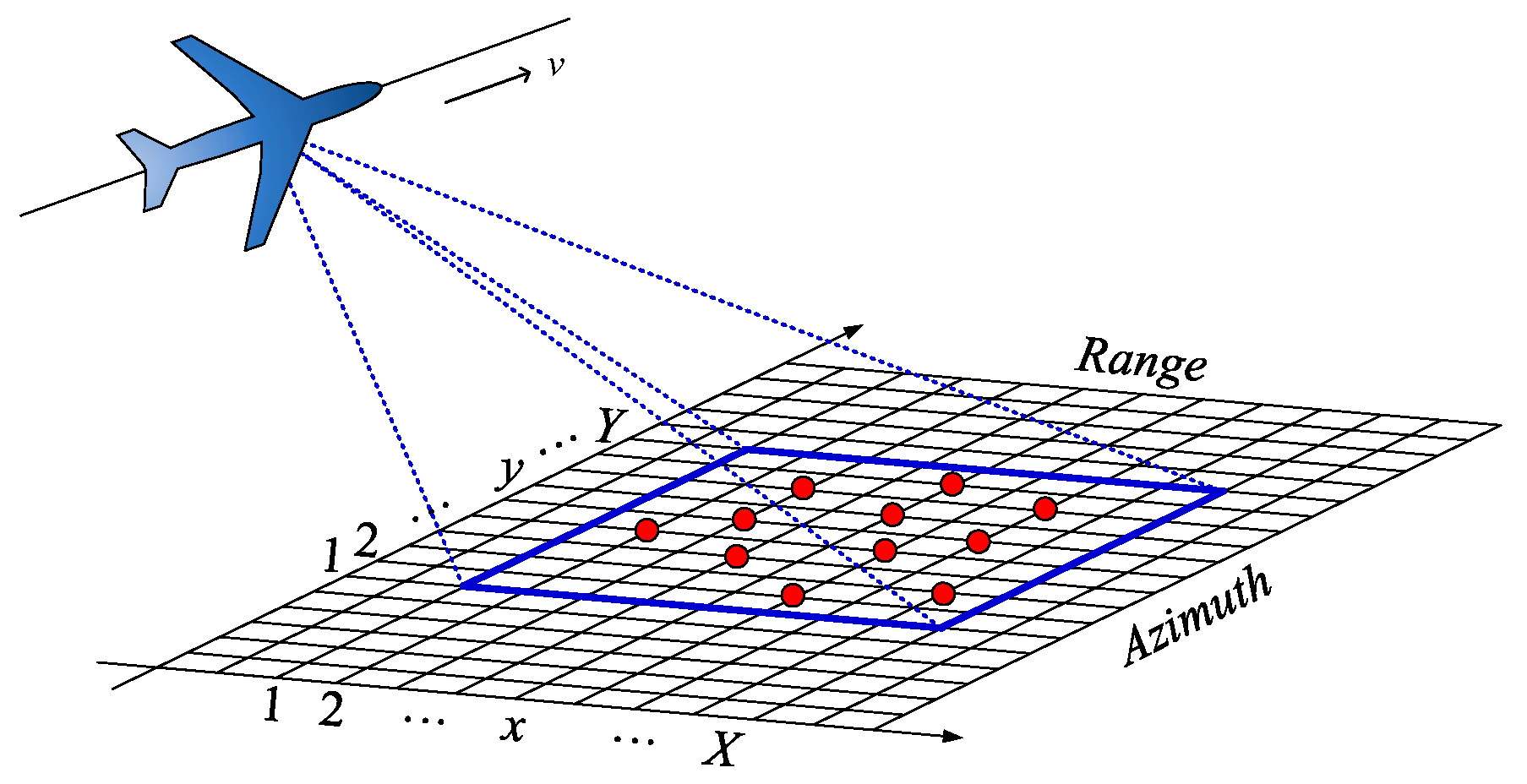

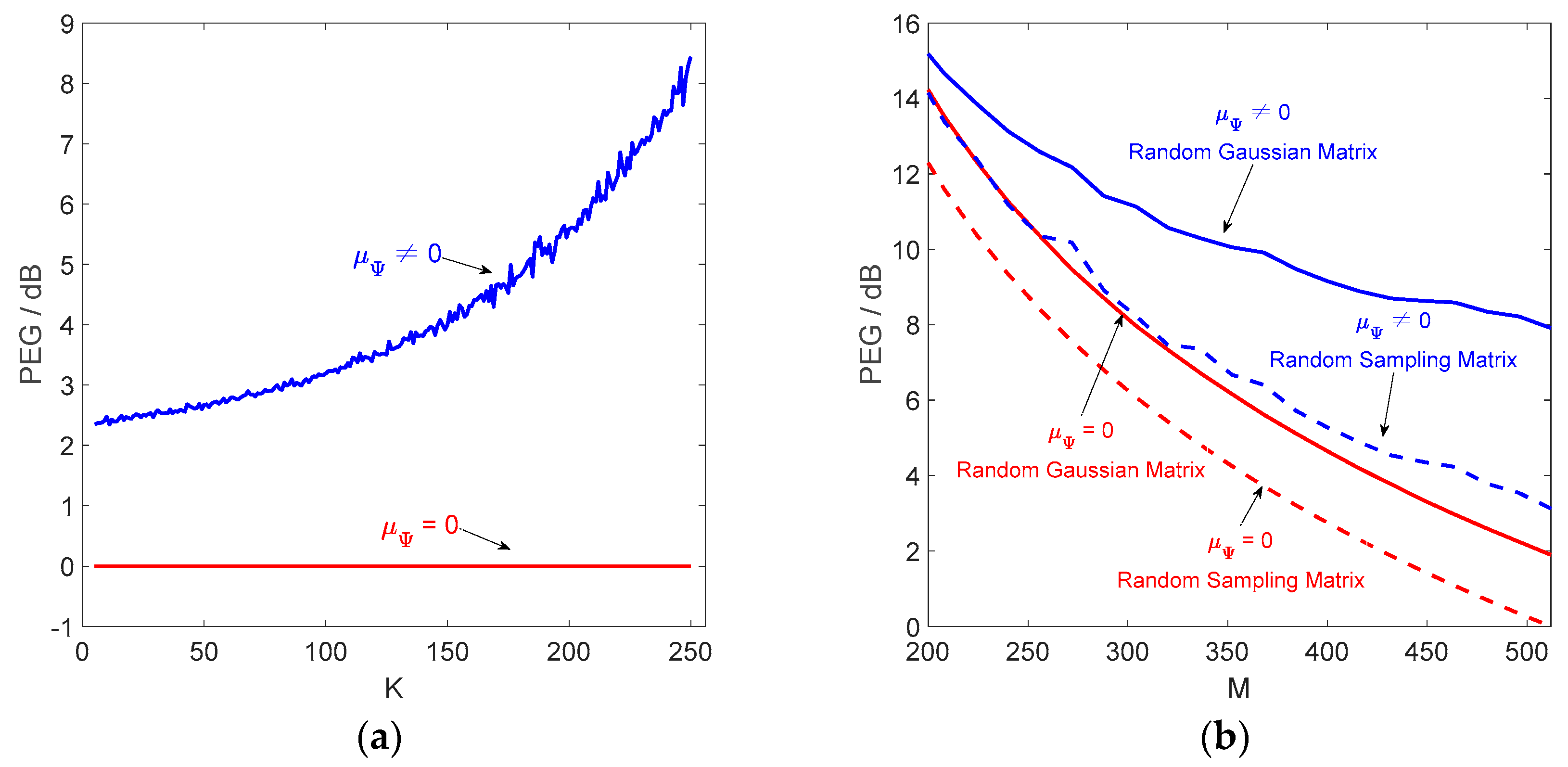



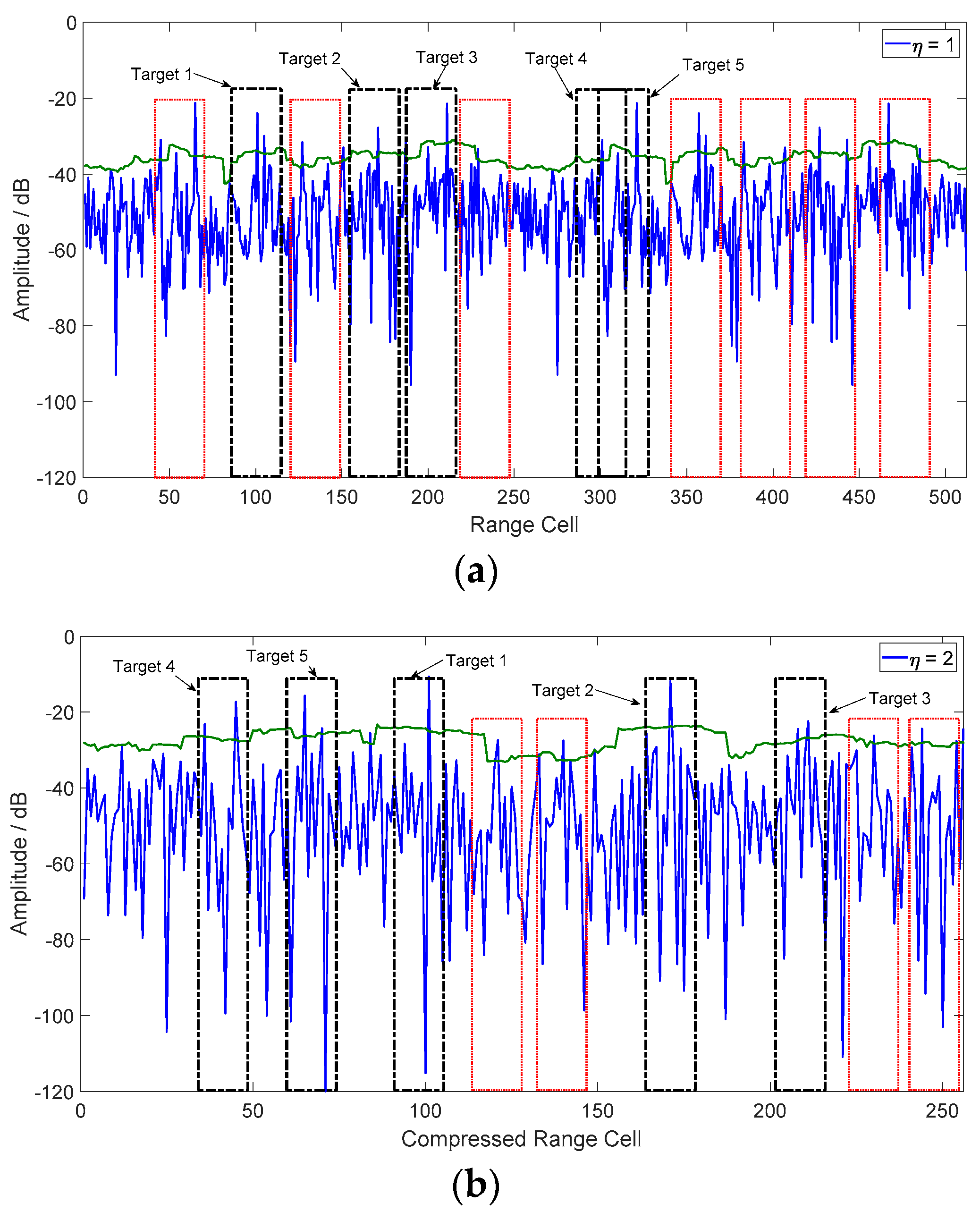
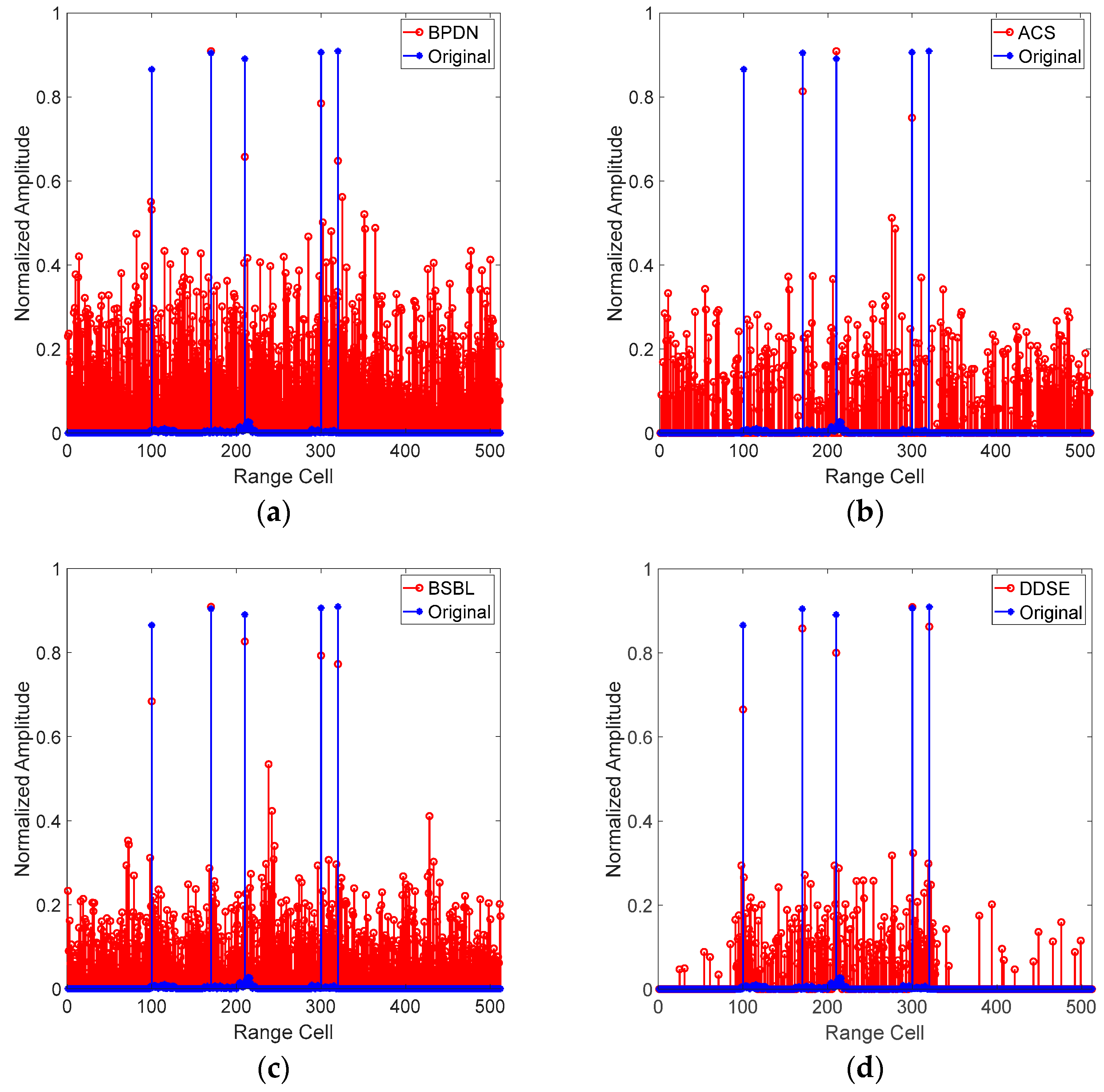
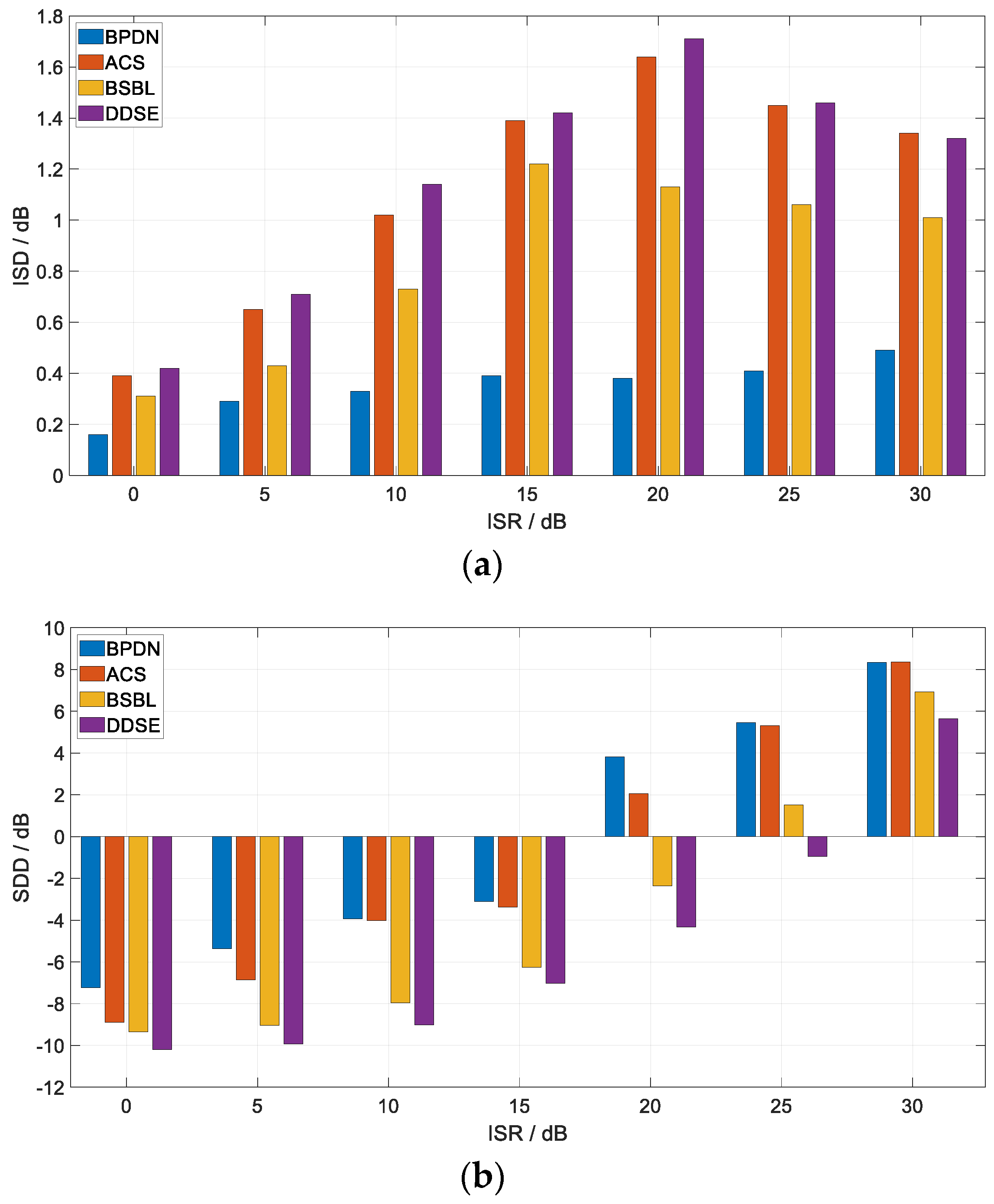

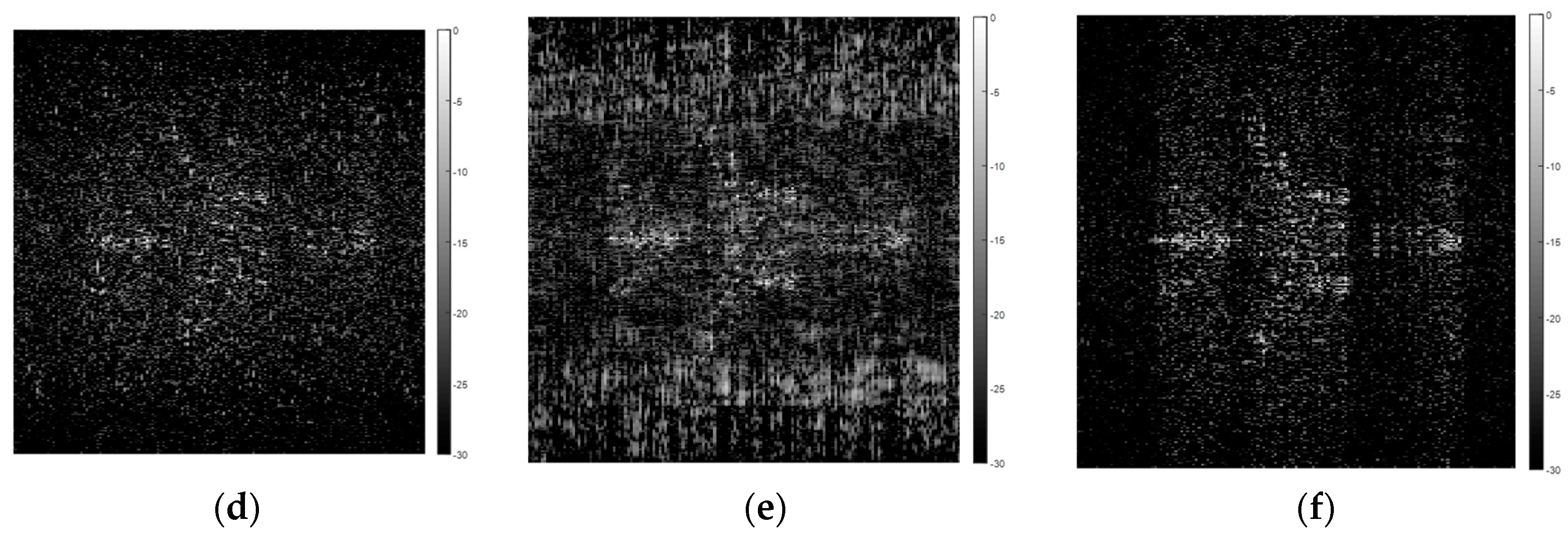
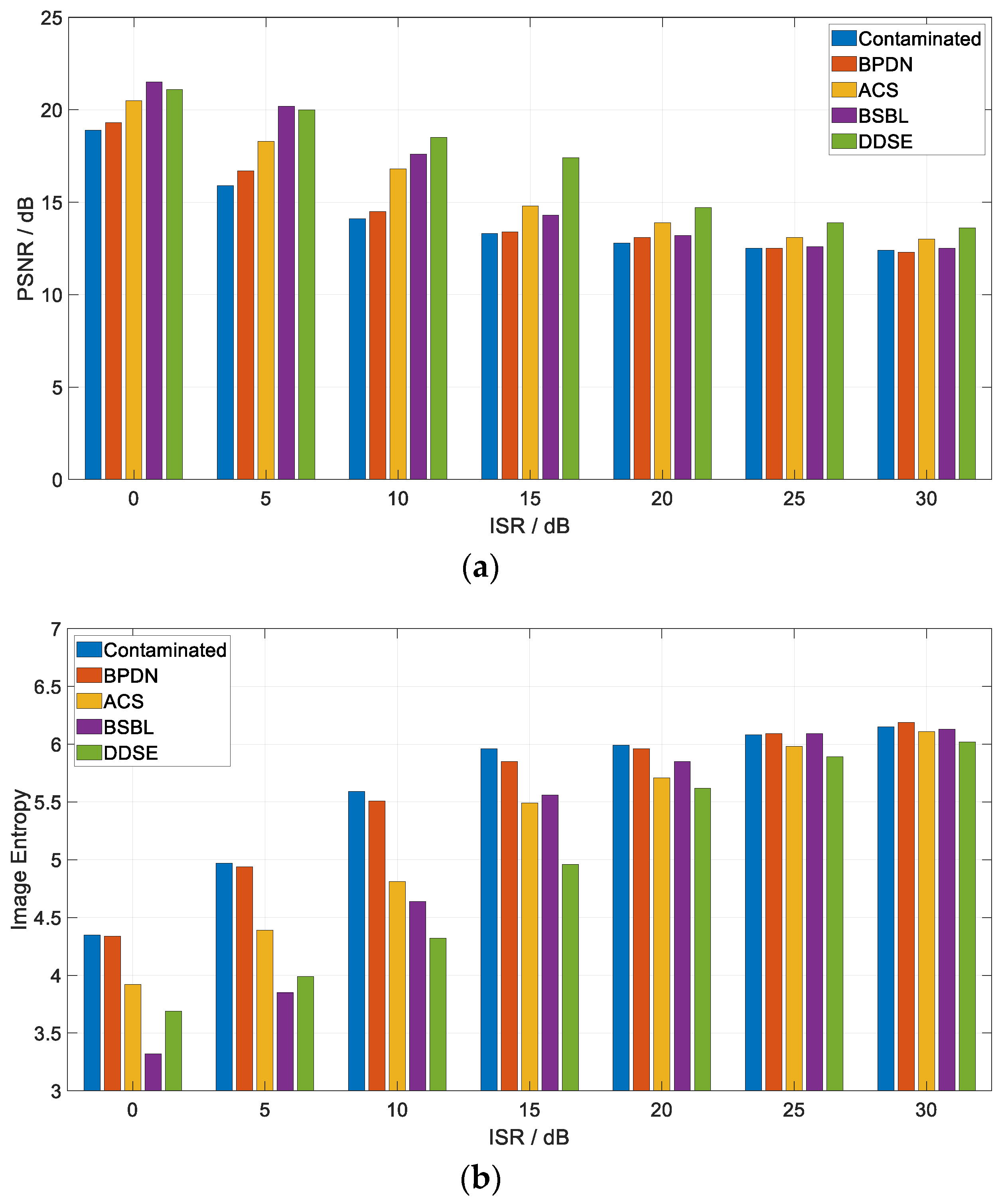
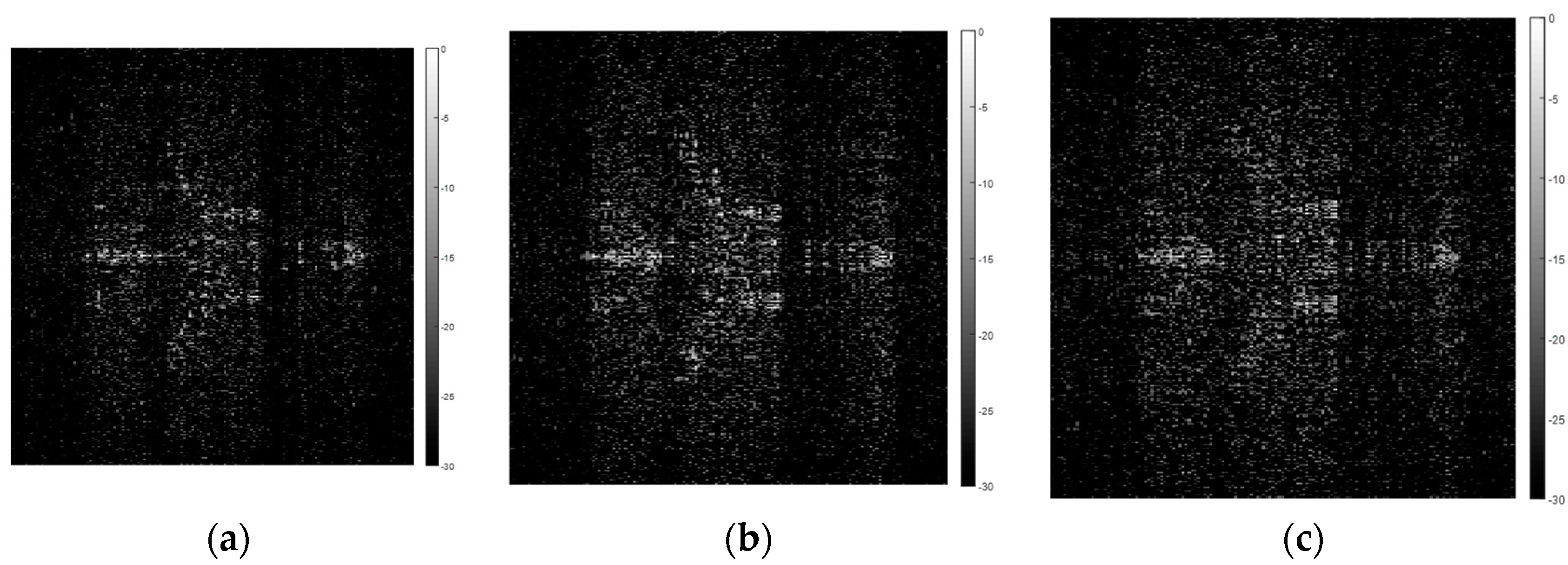
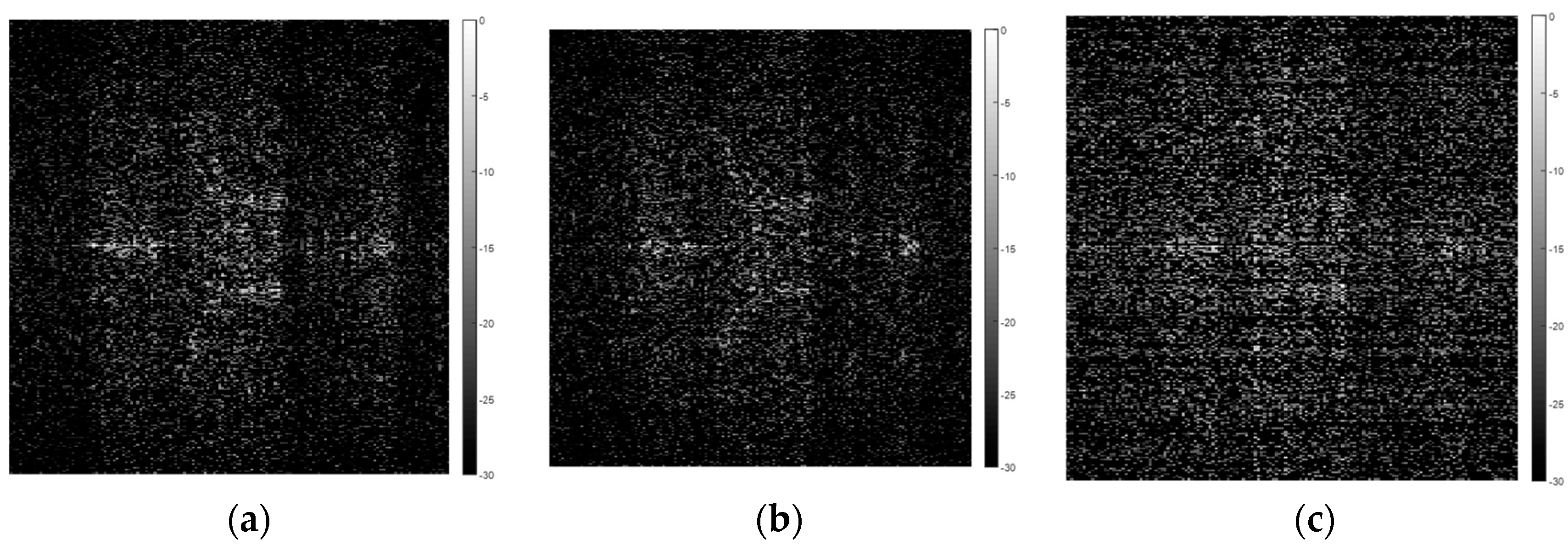
| Parameter Class | Parameter Name | Parameter Value |
|---|---|---|
| Geometric Parameters | Platform height | 3 km |
| Pitch angle | 45° | |
| Scene Range | 128 m | |
| Signal Parameters | Carrier frequency | 3 GHz |
| Bandwidth | 100 MHz | |
| LFM pulse width | 2 μs | |
| Oversampling rate | 1.2 |
| K = 5 | K = 10 | K = 20 | K = 40 | |
|---|---|---|---|---|
| CR = 1/1 | 1.422 | 1.354 | 1.247 | 1.102 |
| CR = 1/2 | 1.417 | 1.352 | 1.226 | 1.097 |
| CR = 1/4 | 1.410 | 1.346 | 1.240 | 1.080 |
| CR = 1/8 | 1.373 | 1.279 | 1.192 | 1.025 |
| K = 5 | K = 10 | K = 20 | K = 40 | |
|---|---|---|---|---|
| CR = 1/1 | −7.035 | −6.685 | −6.104 | −5.217 |
| CR = 1/2 | −6.490 | −5.782 | −4.878 | −3.632 |
| CR = 1/4 | −5.852 | −5.046 | −4.220 | −3.096 |
| CR = 1/8 | −1.507 | −0.879 | −0.121 | −0.274 |
| BPDN | ACS | BSBL | DDSE | |
|---|---|---|---|---|
| K = 5 | 16.825 | 5.325 | 6.827 | 3.364 |
| K = 10 | 17.081 | 6.811 | 6.795 | 4.162 |
| K = 20 | 17.630 | 8.739 | 6.949 | 6.593 |
| K = 40 | 18.533 | 12.447 | 6.952 | −199.259 |
| Parameter Class | Parameter Name | Parameter Value |
|---|---|---|
| Geometric Parameters | Platform height | 3 km |
| Scene range | 128 m × 128 m | |
| Pitch angle | 45° | |
| Squint angle | 0° | |
| Parallel velocity | 150 m/s | |
| Signal Parameters | Carrier frequency | 3 GHz |
| Bandwidth | 100 MHz | |
| LFM pulse width | 2 μs | |
| Oversampling coefficient | 1.2 | |
| Pulse repetition frequency | 125 Hz |
© 2019 by the authors. Licensee MDPI, Basel, Switzerland. This article is an open access article distributed under the terms and conditions of the Creative Commons Attribution (CC BY) license (http://creativecommons.org/licenses/by/4.0/).
Share and Cite
Li, G.; Lu, Q.; Lao, G.; Ye, W. Wideband Noise Interference Suppression for Sparsity-Based SAR Imaging Based on Dechirping and Double Subspace Extraction. Electronics 2019, 8, 1019. https://doi.org/10.3390/electronics8091019
Li G, Lu Q, Lao G, Ye W. Wideband Noise Interference Suppression for Sparsity-Based SAR Imaging Based on Dechirping and Double Subspace Extraction. Electronics. 2019; 8(9):1019. https://doi.org/10.3390/electronics8091019
Chicago/Turabian StyleLi, Guojing, Qinglin Lu, Guochao Lao, and Wei Ye. 2019. "Wideband Noise Interference Suppression for Sparsity-Based SAR Imaging Based on Dechirping and Double Subspace Extraction" Electronics 8, no. 9: 1019. https://doi.org/10.3390/electronics8091019
APA StyleLi, G., Lu, Q., Lao, G., & Ye, W. (2019). Wideband Noise Interference Suppression for Sparsity-Based SAR Imaging Based on Dechirping and Double Subspace Extraction. Electronics, 8(9), 1019. https://doi.org/10.3390/electronics8091019




